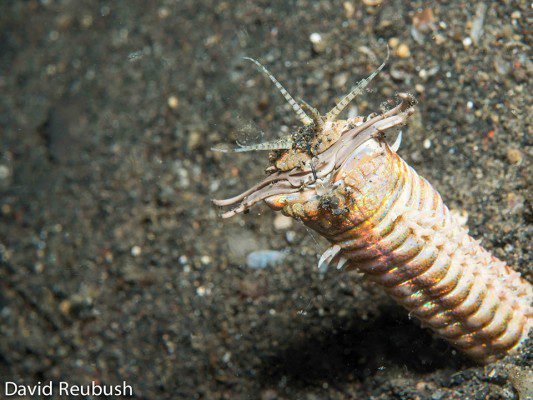
When we think about speed in the ocean, we often picture sleek fish darting around. But the Bobbit worm, with its long, segmented body and bristled appendages, takes a whole different approach. They can deliver astonishingly quick strikes that are hard to believe! So how fast can these amazing creatures really move? Let’s dive deeper and explore the incredible world of Bobbit worms and their lightning-fast attacks.
What Are Bobbit Worms?
To really appreciate how fast Bobbit worms can strike, it’s good to know what they are. Bobbit worms, or *Eunice aphroditois*, are marine polychaete worms that can grow up to 10 feet long! They’re often found buried in sand or mud on the ocean floor. Their vibrant colors, like greens, blues, or reds, help them blend in with their surroundings, making it tough for prey to spot them.
These worms have a unique structure: a series of segments that are covered in bristles. Each segment can move independently, giving them a flexibility that helps them respond quickly to threats or opportunities. When they sense movement, they can strike with impressive speed—something that’s vital for catching food.
So, what do they eat? Bobbit worms primarily feast on small fish, crustaceans, and other unsuspecting marine creatures that pass by. Once they detect movement, they’re ready to launch their attack.
How Do Bobbit Worms Strike?
Now, let’s get to the fun part—the strike! Bobbit worms can strike at incredible speeds, sometimes hitting their target within just a fraction of a second. This quickness is key to their hunting strategy. Instead of swimming after their food, they rely on stealth and surprise.
When a potential meal swims too close, the Bobbit worm detects vibrations in the water with its antennae. It remains motionless until the perfect moment arrives. Then, in a blink, it extends its powerful jaws—somewhat like a snake—grabbing its prey with a ferocity that surprises anyone who witnesses it.
Interestingly, their jaws are equipped with sharp teeth that help them hold on tightly to their catch. Once they’ve grabbed their food, they pull it down into their burrow, ensuring it won’t escape. This hidden approach makes them excellent ambush predators.
How Fast Are They Really?
Scientific studies estimate that Bobbit worms can strike in as little as 0.2 seconds! To put that into perspective, that’s faster than a person can blink. This speed is largely due to their specialized muscle structure, which allows them to react immediately when they detect movement nearby.
If we compare this speed to other marine animals, it’s pretty impressive. For example, a snapping turtle can strike in about 0.1 seconds, but they don’t have the same level of agility that Bobbit worms do in their underwater environment. The Bobbit worm’s swift reaction time gives it an edge, allowing it to catch prey that may not even know it’s in danger until it’s too late.
Why Does Their Speed Matter?
You might wonder, “Why is this speed so important?” Well, in the underwater world, every second counts. Many marine creatures rely on high-speed responses to survive. For Bobbit worms, being able to strike quickly means they can secure food before it escapes or is snatched up by another predator.
Additionally, their speed helps them defend themselves. If threatened, the quick strike can be used to fend off potential attackers or competitors. The ability to react faster than predators helps maintain their place in the ocean’s complex food web.
Common Myths About Bobbit Worms
With all this talk about speed, there are a few myths surrounding Bobbit worms that are worth noting. One common misconception is that they can attack humans. While these worms have powerful jaws, they typically prefer smaller prey and are not known to pose a threat to divers or snorkelers.
Another myth is that they can grow as long as 30 feet. While their lengths can be impressive, most Bobbit worms reach about 3 to 10 feet in length. The tales of the giant 30-foot Bobbit worm are likely to be exaggerated.
Where Can You Find Bobbit Worms?
If you’re curious about seeing a Bobbit worm in action, they’re mostly found in tropical and subtropical oceans around the world. They thrive in coral reefs or sandy ocean floors, where they can bury themselves and remain hidden from view.
But remember, spotting one isn’t easy! They spend most of their lives concealed from sight. If you’re diving or snorkeling, it might take a keen eye to find them. Look for a small opening in the sand or mud—sometimes, you might just catch a glimpse of their colorful antennae.
Bobbit worms are some of the ocean’s most incredible creatures, showcasing a remarkable ability to strike quickly and effectively. With speeds reaching up to 0.2 seconds, they’ve mastered the art of ambush hunting in their unique underwater environment.
Understanding how these worms operate not only piques our curiosity but also highlights the extraordinary adaptations found in the marine world. So, the next time you hear about these remarkable creatures, you can impress your friends with the fact that Bobbit worms are like the ninjas of the ocean—quick, stealthy, and undeniably fascinating!
